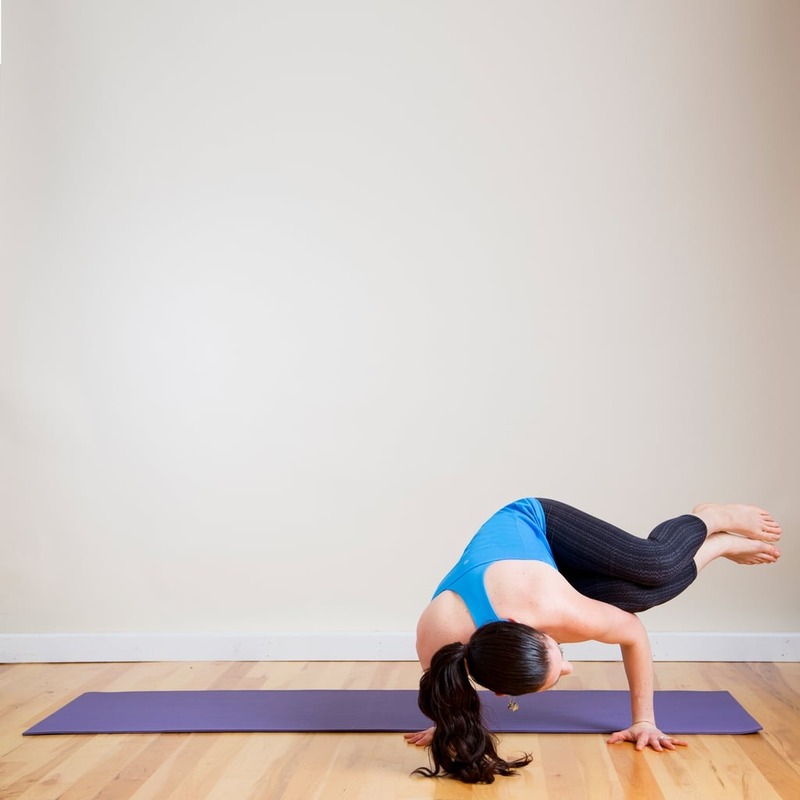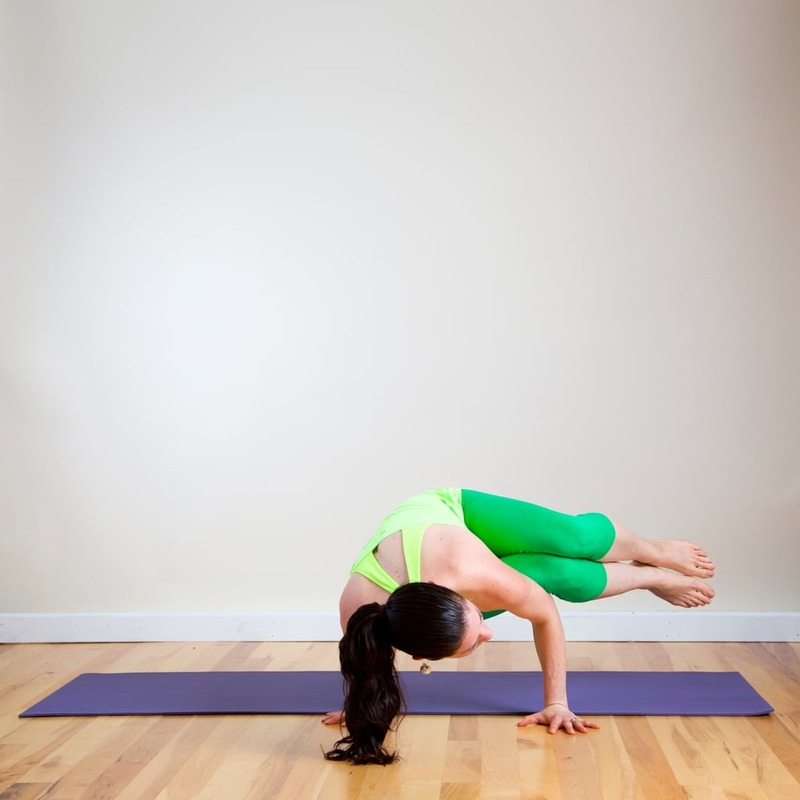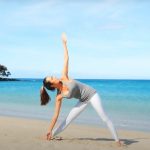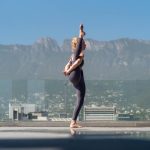Introduction to Yoga Side Crow Pose
Embarking on the journey to master the Yoga Side Crow Pose, or Parsva Bakasana, is a thrilling pursuit for yogis seeking to deepen their practice. This arm balance is not just a display of physical prowess but a testament to the perfect harmony between strength, flexibility, and mental focus. It offers a composite workout, targeting various muscle groups and cultivating an unwavering mind-body connection.
The Anatomical Breakdown of Parsva Bakasana
To understand Side Crow, let’s dive into its anatomy. It’s a pose that combines a deep twist with an arm balance. Your arms and wrists support your body weight, while your core muscles work overtime to maintain your posture. Your legs, engaged and compact, contribute to the overall stability, while your gaze (Drishti) helps anchor your focus and balance.
The Benefits of Practicing Yoga Side Crow Pose
Practicing Side Crow reaps several benefits. It builds upper body strength, hones your core’s endurance, and improves your balance and focus. Regular practice can invigorate your digestive health and offer a sense of accomplishment, boosting your overall well-being and yoga confidence.

Preparatory Poses for Yoga Side Crow Pose
Before attempting the Side Crow pose, certain preparatory poses can create a solid foundation. These poses focus on building the core strength, upper body stability, and twist flexibility necessary for a successful arm balance.
Building Core Strength for Arm Balances
A strong core is crucial for balancing and lifting the body in arm balance poses. Here are some core-strengthening exercises to prepare for Side Crow:
- Plank Pose: Hold a plank for 30 seconds to one minute to build endurance in your core muscles.
- Boat Pose: This pose targets your deep core muscles, helping improve balance.
- Dolphin Plank: An excellent pose for strengthening the core, arms, and shoulders.
Practice these poses regularly to develop a core that’s ready for arm balances like Side Crow.
Enhancing Upper Body and Wrist Stability
Upper body and wrist strength are key to supporting your weight in Side Crow. Include these poses in your routine:
- Downward-Facing Dog: Strengthens arms and shoulders while stretching the wrists.
- Chaturanga Dandasana: Builds arm and shoulder strength and prepares the wrists for bearing body weight.
- Wrist warm-up exercises: Rotate your wrists and gently stretch them in different directions before attempting Side Crow.
These exercises will help enhance the strength and flexibility of your upper body and wrists.
Hip Flexibility and Twisting Fundamentals
Hip flexibility and the ability to twist deeply are necessary for maintaining the compact shape required in Side Crow. Here are some preparatory poses for hip flexibility and twisting:
- Revolved Chair Pose: Provides a deep twist and warms up the hips and spine for Side Crow.
- Marichyasana III (Marichi’s Pose): Enhances the capability to perform deep twists essential for the Side Crow.
- Garland Pose (Malasana): Opens up the hips, preparing them for the squatting aspect of Side Crow.
Incorporate these into your practice to work on the flexibility needed for a solid Side Crow pose.
Step-by-Step Guide to Side Crow
Navigating the Side Crow Yoga Pose requires patience and precision. Let’s break it down into manageable steps.
Starting with Chair Pose and the Twist
Begin in Chair Pose (Utkatasana). Stand with feet together, bending your knees deeply. Lean forward slightly, with your torso. Bring your palms into prayer position at your chest. Now, twist to one side, hooking your elbow outside of the opposite thigh. Keep your hips square and knees in line.
The Transition to Arms and Palms Placement
Shift the weight into the balls of your feet. Place your hands flat on the floor beside you, about shoulder-width apart. Make sure your fingers are widely spread. Tilt your body forward, letting your thigh rest on your elbow.
Finding Your Balance and Lifting the Feet
Continue to lean forward, engaging your core muscles. Start lifting your feet off the ground, balancing on your palms. Keep your gaze fixed ahead to help with balance. Try to keep your elbows in line with your shoulders, not splaying out to the sides. Your feet should now be hovering as you maintain the posture. Focus on the feeling of strength in your core and arms.

Common Challenges and Tips for Yoga Side Crow Pose
Overcoming Fear of Falling in Arm Balances
One common hurdle when learning Side Crow is the fear of falling. Here are tips to tackle this challenge:
- Practice on a soft surface or use a yoga mat to minimize discomfort from falls.
- Use yoga blocks or a pillow in front of you for a safe landing in case you tip forward.
- Begin by simply leaning and shifting weight to your hands without lifting your feet yet.
- Visualize the pose in your mind to build mental readiness and reduce fear.
Alignment Corrections and the Importance of Gaze
Proper alignment is crucial for stability in Side Crow. Here are key points to check your pose:
- Ensure your fingers are spread wide and press firmly into the mat.
- Align elbows beneath the shoulders to create a strong foundation.
- Keep your gaze forward, not down, which helps maintain balance.
Remember, your gaze, or Drishti, often directs your body’s balance, so look ahead, not down.
Engaging Core Muscles for Better Balance
A strong core supports the entire Side Crow pose. Strengthen your core with these tips:
- Engage the abdominal muscles by drawing the navel towards the spine.
- Think of lifting upwards rather than just leaning forward to avoid collapsing.
- Perform core-strengthening exercises regularly to enhance arm balance capability.
Through persistence and focus, these adjustments will lead to a more stable and controlled Side Crow.
Advanced Variations of Side Crow Pose
Once comfortable with Side Crow, it’s time for advanced variations. These challenge balance, strength, and flexibility more deeply. Progress with caution and mindfulness.
Side Crow with One Leg Extended
This demanding version boosts the intensity of the classic Side Crow. Enter the standard pose first. Then, straighten one leg out to the side. Hold your balance, keep your core engaged, and focus on a steady gaze. Return your foot to meet the other before you exit the pose.
Exploring the Eka Pada Koundinyasana Transition
From Side Crow, you can transition to Eka Pada Koundinyasana. With feet lifted in Side Crow, extend one leg forward and the other back. Create a diagonal line with your body. The pose demands core control and arm strength. Practice this transition to build dynamic movement in your arm balances.
Deepening the Twist in the Side Crow
Enhance your Side Crow by deepening the torso twist. This requires more spinal flexibility. Maintain your balance as you twist further. Keep your hips lifted and arms strong. Concentrate on your breath to help deepen the twist. This variation increases the pose’s detoxifying effect.

Cool Down and Counterposes after Side Crow
Once you’ve completed your journey with the Side Crow pose, it’s vital to balance your practice with a series of cooling and counterbalancing poses. These will alleviate any tension created and promote a harmonious conclusion to your session.
Twists to Forward Bends Transition
After the intense twists of Side Crow, gently transition into forward bends. Start with a simple seated forward bend to elongate the spine and calm the nervous system. This move aids your body in releasing any remaining tension from the arm balance.
Incorporating Backbends and Restorative Poses
Backbends like Bridge Pose can counterpose the forward fold of Side Crow by stretching the front body and opening the chest. Afterward, involve restorative poses such as Child’s Pose or Supine Twist to settle the body and mind.
Seated Meditation and Savasana for Integration
To wrap up your practice, spend a few minutes in seated meditation. This helps to internalize the benefits of Side Crow and the subsequent poses. Conclude with Savasana, allowing for full integration of your physical and mental efforts into a state of deep rest and relaxation.
Concluding Thoughts on Yoga Side Crow Pose Practice
As we wrap up our exploration of the Side Crow Pose or Parsva Bakasana, it’s clear that this arm balance is more than just an impressive party trick. It’s a mix of physical demands, mental focus, and breath coordination, which, when combined, deepen your yoga journey and offer profound benefits.
Regular practice of Side Crow can significantly boost your core strength, arm and wrist stability, and mental perseverance. It’s not just about conquering a pose; it’s about the process and what you learn about yourself along the way. The pose teaches patience, builds resilience, and provides a unique way to gauge your progress over time.
As you continue practicing, you may notice improvements in other aspects of your daily life, such as better posture, enhanced focus, and a stronger, more supple body. The practice becomes a reflection of your dedication and a metaphor for overcoming life’s challenges.
Remember, the journey is personal. Each fall and rise teaches a new lesson. Don’t rush it, enjoy each step, and honor your body’s signals. Celebrate the victories, both big and small, as they each contribute to your growth.
Incorporate Yoga Side Crow Pose into your sequences, challenge yourself with its variations, and don’t forget to cool down afterward with poses that will bring balance back to your body. Above all, let the essence of Side Crow—balance, strength, and poise—infuse your practice and everyday life. Keep coming back to your mat, keep exploring, and enjoy the beautiful process of personal evolution through yoga.


